This might be the most beautiful place in America.
Walk with me.
Walk awhile up and down these Kansas hills, where the tallgrass prairie rolls out deep green on every side, the land rising and falling to a faraway horizon, out to the silent edge of a high, hot sky, the big bluestem and the wild alfalfa and the switchgrass and the Indian grass and the buffalo grass waving and swaying in the wind, gathering in the streambeds where the Eastern red cedar and the cottonwood shadow the springs and seeps, until even your own footsteps sound far away and that abiding green reaches for you and finally, gratefully, you feel yourself dissolving into the immensity of the world. You are taken up, even as you slip away. This landscape is its own poetry, a match for the breadth and reach of your imagination, a wilderness of perfect solitude. There are no politics here, only peace; no sadness, only hope; no doubt, only certainty. Not a house, not a fence, not a single human sign, only you, alone at last and at one with everything.
Until you crest that final gentle rise—and there in front of you are 6,000 people and the Kansas City Symphony Orchestra. And as the familiar moderato of Smetana’s “Moldau” in E minor from Ma Vlast is carried away on a stiff wind, along with the mooing of half a hundred cattle, you’ll be forgiven for thinking you’ve lost your goddamned mind. Seriously. It’s like that scene in Fitzcarraldo where they haul the steamship over the mountain. An opera house in the Amazon jungle? Sure. A symphony on the prairie in the middle of nowhere? Whatever.
This is June in Kansas and this is Symphony in the Flint Hills.
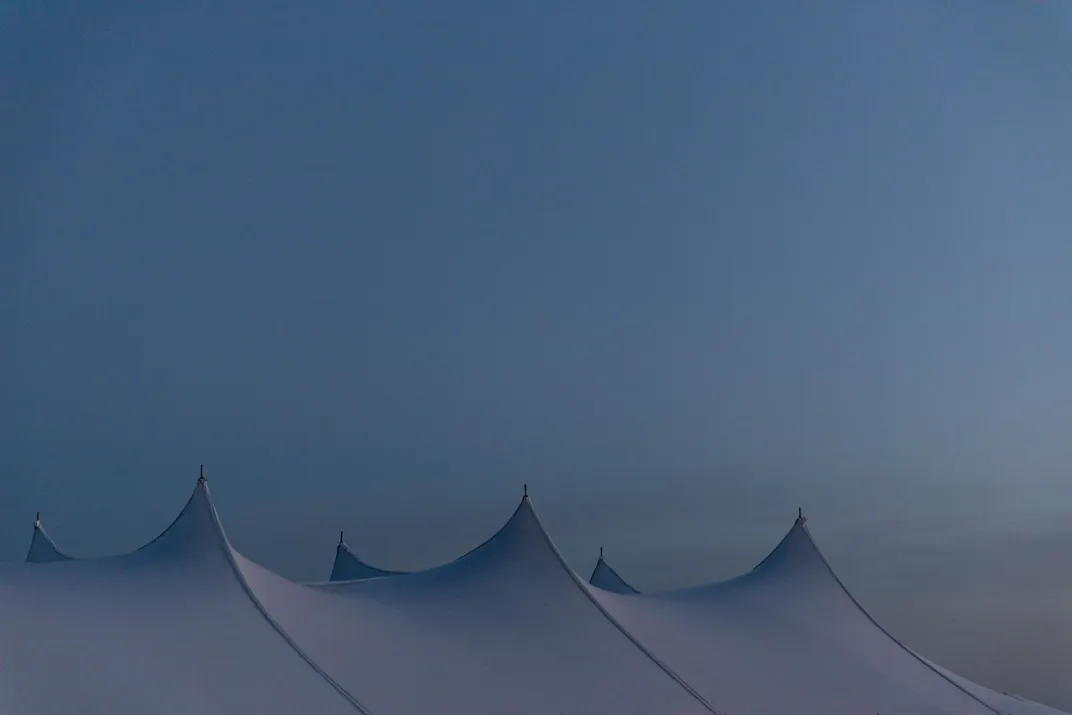
Oh, Give Me a Home
Start here: the map on Annie Wilson’s dining room table.
Annie Wilson is a rancher and an educator and a lawyer and a songwriter and a singer. Mostly these days people seem to know her for her singing. She has a fine voice, sweet but resolute. You can often catch her on Friday nights at the Cottonwood Falls artist’s co-op open mic. She is also the official, state-appointed, governor-approved Flint Hills Balladeer. She is slender and sharp-featured and wears glasses and has blond hair she sometimes keeps in a pair of unbraided pigtails or lets down when she sings. She is at the age when folks stop asking your age. In the pictures for the album covers she wears a red sash at her waist and a big straw cowboy hat. She writes songs with titles like Sail the Summer Sky and My Diamond Creek Cowboy and Big Bluestem: King of the Prairie.
She and her husband, John, live on a ranch a few miles west of Elmdale, Kansas, which is itself a few miles west of Cottonwood Falls, Kansas, which is itself pretty far from anywhere, but is the home of the loveliest little government building in the country, the Chase County Courthouse. We’re two hours southwest of Kansas City, Missouri, by car—or more likely by charcoal gray metallic F-350 crew cab Powerstroke dualie with a fifth wheel hitch, two bales of hay and a Rubbermaid filled with horseshoeing tools in the bed.
This is the center of the Flint Hills.
* * *
Annie has been pointing this out on the map, which she helped develop and distributes along with lesson plans to regional schools and museums. The map shows what amounts to the last of the tallgrass prairie in America. There used to be 170 million acres of it from Canada down to Texas. We plowed most of it under. Almost all of it. Outside a few preserves and set-asides, much of what little is left now occupies a 60-mile-wide wedge of bright green running from about Blue Rapids, Kansas, down to Fairfax, Oklahoma. Annie’s map details the last few acres of one of earth’s greatest and fastest-disappearing temperate grasslands. For the past 40 years, she and her neighbors have been fighting like hell—sometimes with each other—to keep it intact.
The threats to this fragile landscape are many, and immediate and far too familiar. Real estate and commercial development. Pollution. Extraction. Invasive plants. Climate change. Power generation, wind farms, oil fields, fracking, pipelines, dams, highways.
Sitting at her dining room table, we go through the ecology and the science and the history of this place, the economy and the geology and the politics, some of which finds its way into the grade-appropriate lesson plans Annie writes for the school districts.
Around 275 million years ago, Kansas was the eastern floor of a warm, shallow body of water covering much of what is now the American Midwest. For hundreds of centuries, as minerals and tiny dead sea critters settled to the bottom along with their contribution of calcium carbonate, limestone was forming on the ocean bed. In the cracks and crevices of that limestone were the mudstones and cherts—call them shale and flint—that now make up the soft rock/hard rock layer cake of these hills. Bake for a few million years. Leave that cake out in the rain long enough and it eventually erodes into the rounded swells and tabletops and washes we walk today.
For thousands of years, the first people of North America walked it, and came and went across these sunshot hills and hollows hunting bison and elk. Europeans eventually hiked blinking out of the claustrophobic Eastern forests and by the beginning of the 19th century, exploration here was underway in earnest. In 1806, Zebulon Pike, footsore and no great speller, gave the place its name when noting in his journal “Commenced our march at seven o’clock. Passed very ruff flint hills. My feet blistered and very sore.” Down in Oklahoma, these are called the Osage Hills and make up a substantial part of the land overseen by and under the care of the Osage Nation. Then and now, from microbes to migratory birds, the tallgrass prairie is one of the richest, most diverse ecosystems on the continent.
By the middle 1800s there were homesteaders and farmers coming and going and tearing up the prairies with their newfangled steel plows. And once that native grass is plowed, it never comes back as it was. Never. Nor does the habitat it provides for innumerable species of animal life. What saved these hills was the flint.
And the shale and the limestone. You couldn’t get a plow into it. So the pioneers left the uplands alone, but tilled most of that rich acreage down in the bottoms by the rivers and the streams.
Out on the hills they ran cattle, and cattle mean cowboys—and inevitably commerce and ranches and fences and towns and railroads, and the economy and the mythology of the Flint Hills were well and truly launched by about 1880.
Because it turns out the tallgrass prairie is not only stunning, but luscious. Cattle fatten fast here, profitably so, and over the years the Flint Hills became famous for its vast ranches and transient beef operations. Bring in a herd of market cattle for a few months, fatten them up and ship them back out. Part of that has to do with above-average rainfall in eastern Kansas and the way the limestone stores or redistributes it; part of it has to do with the nutritive value of those deep-rooted prairie grasses pulling valuable proteins and minerals up to where the cattle can make use of them; part has to do with the heritage of hard work every rancher shares with every other; and part has to do with fire.
In early spring, ranchers here burn a regional patchwork of pastureland. Flames 30 feet high! Smoke so thick it closes the interstate! A week or two or three later, those blackened acres come back green and bright as an emerald. The new growth is irresistible to cattle. And for thousands of years before that, to the buffalo. Native people burned the tallgrass too, as an attracter for the elk and bison they hunted. And fire keeps the prairie from being overrun by trees. Back into prehistory, lightning did that work.
So earth, air, fire and water. Two hundred seventy-five million years’ worth of it. Makes it seem simple.
But history is ruffer even than flint. The death and displacement of Native Americans in service of “Manifest Destiny” or free enterprise or private property cannot be ignored. Nor can the environmental costs of development and profit-taking on these last few acres of one of the country’s greatest treasures. This is some of the most contested ground in America.
The fight among ranchers and farmers and environmentalists and politicians and energy producers will never be completely settled. But lasting alliances and a lot of progress have been made lately. For example, it seems intuitive that ranchers were the most natural stewards of the remaining tallgrass, and stood to benefit most by its careful management. As conservationists learned not to villainize them, but rather to work with them and guide them to best practices—and the ranchers learned to listen and compromise—they all found themselves on the same side. Partnerships between public and private interests, scientists and politicians, the National Park Service and the Nature Conservancy have been helping protect more and more land here by limiting development with conservation easements. The easements are voluntary and legally binding. They place permanent restrictions on how landowners can use private property, by specifying which resources are to be protected. They’ve been an elegant answer in a polarizing debate. But the essential tension between profit and preservation is a constant. The prairie only feels infinite. It is not.
Annie’s quiet for a minute. The dining room is lined with family photos. Just then she says, “I think that our best hope through all this is education. I feel like what can bring us together, what we can do, is find common ground, and that is our love of the land. I really believe all of the sides do love the land.”
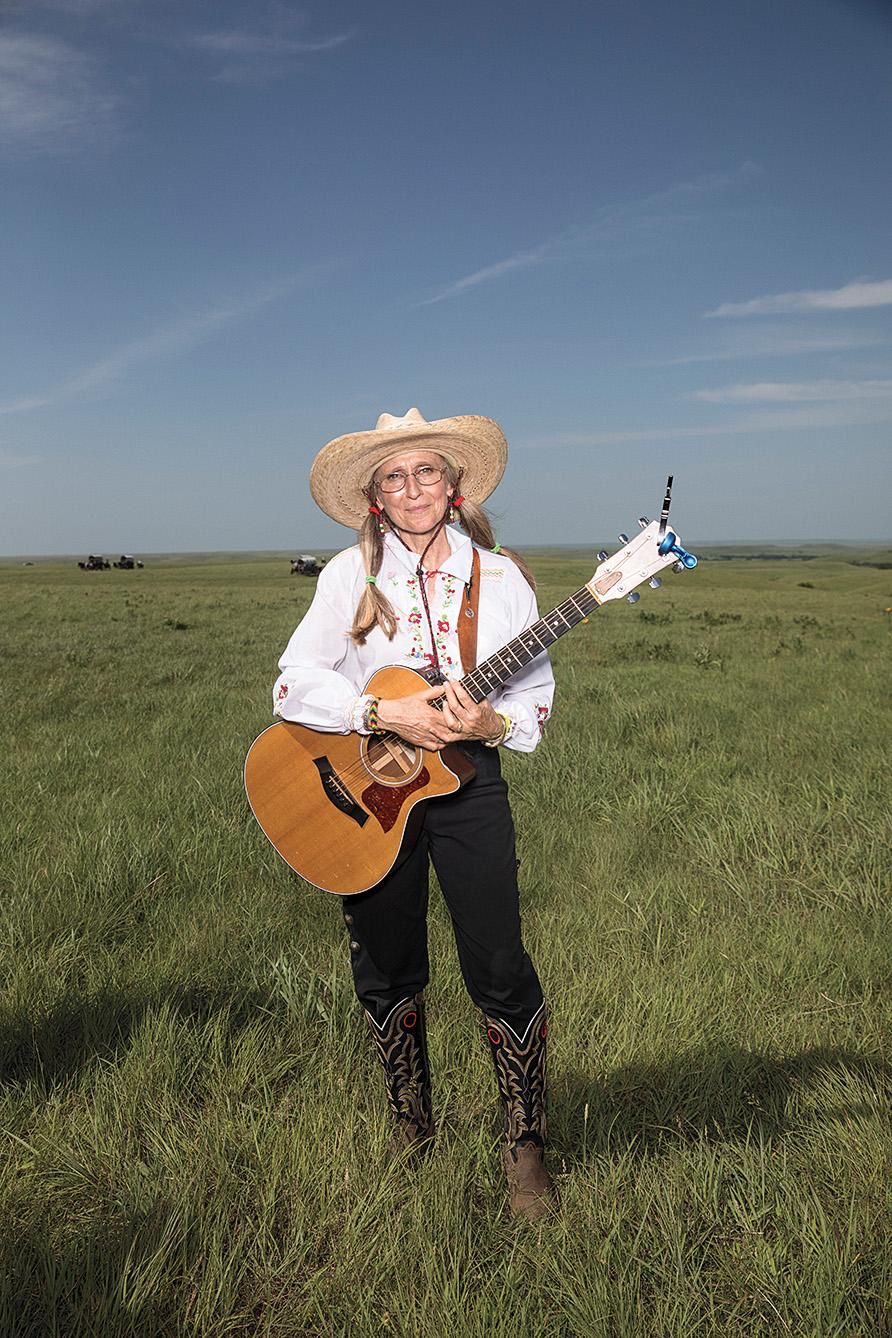
Where the Buffalo Roam
Brian Obermeyer, bearded and affable, is the Flint Hills project director at the Nature Conservancy (TNC). Kristen Hase, of the National Park Service, is the chief of natural resources and acting superintendent of the Tallgrass Prairie National Preserve. Her ranger hat is perfect. They run the Preserve together.
This is where the buffalo roam.
The Preserve used to be the old Z Bar Ranch. Before that it was the Spring Hill Ranch, and it’s a beauty. More than 10,000 acres of rolling tallgrass, a limestone mansion with a giant limestone barn, and its own herd of American bison. About a hundred head. It became a national preserve in 1996. Hase and Obermeyer go back and forth like old college chums from Emporia State, which is what they are.
“It is a unique public-private partnership between NPS and TNC,” says Obermeyer. “We’re the third private landowner since establishment of the Preserve. Before that, it was in the National Park Trust, and they ran into some financial challenges and so TNC stepped in and acquired the property. It’s a nearly 11,000-acre property, and the Park Service owns only about 34 acres, but the entire property is a unit of the National Park Service.
“Nancy Kassebaum proposed this idea of a new model for the National Park Service, where the park’s privately owned and the government cannot own more than 180 acres of this park.
“The ranches see the advantage of the preservation. Because that’s agreeable to the ancient practice of the bison. They’re going to move across the land, and they’re going to eat and eat and eat, and then they’re going to go away. Then things will burn in the spring, and then they’ll come back in the next. That’s the classic cycle, and the ranchers go along with that because that’s how they do their work anyway.
“Altogether, I think we’re at about 110,000 acres of conservation easements in the Flint Hills. The goal for the Flint Hills Legacy Conservation Area is to eventually have 1.1 million acres of conservation easements in the Flint Hills.”
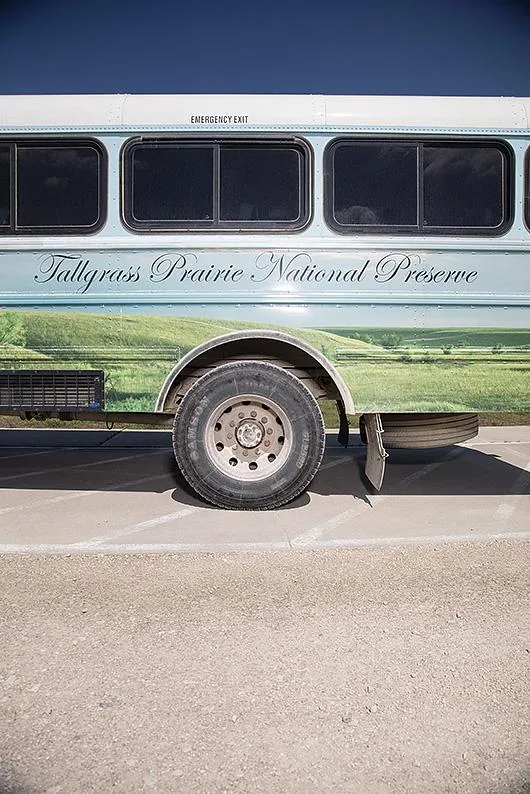
* * *
Rob Manes is the state director for the Nature Conservancy in Kansas. His smile is a beacon and his dress shirt is pressed to crisp perfection. And his concerns for the Flint Hills are pressure from wind energy and agricultural encroachments and water pollution and commercial development and the oil business and nuisance plants and invasive species like Johnson grass and Eastern red cedar and honey locust and smooth sumac and humans.
If you stop the burns, the whole prairie will be lost to trees in 30 to 50 years. But if you burn too much too often, you destroy habitat for threatened species like the lesser prairie chicken. If you graze off or plow under too much of the native grasses, maybe those fields come back choked with less palatable, less nutritious Old World bluestems, introduced by us 100 years ago for forage and to control erosion and now everywhere along the roadsides and fence lines.
Big bluestem, scientific name Andropogon gerardii, is the King Kong of the Flint Hills, the anchor grass. Its roots and tillers literally hold these hills together, a web traveling deep into the rock and soil, gripping the flint and stabilizing the substructure while pumping moisture and mineral-rich nutrients up to the blades—there to be eaten by the beef or the bison or the woolly mammoth. It is a thing to see. Walking in an uncropped field, an ungrazed tallgrass pasture on a hillside in the wind, is like swimming in a soft green sea.
Late-arriving grasses with names like villains from “Game of Thrones,” Bothriochloa bladhii and Chloris verticillata—Caucasian bluestem and windmill grass—crowd out the native tallgrass. Push down hard on a possible solution here, and a thornier new problem pops up over there. Worst case? The whole prairie collapses in a couple of decades.
Nature is perfect. But once touched, how do we untouch it?
And yet Manes, emphatically, is an optimist. “We don’t have to have the science perfect. We don’t have to have perfect answers. We don’t have to get the economics perfect. We just gotta get close and get started. Most of the agricultural producers, most of the industry folks are ready to go. I know we’re better people than to pass on an easy opportunity like this. The same is true with agriculture as it is with renewable energy and climate change. We can fix this stuff. The foothills don’t have to disappear into a boiling climate, or the dust of a plow. The foothills can be here for our great-great-grandchildren.”
Jim Hoy is a well-regarded author and folklorist and professor, with a doctorate in Medieval and Renaissance English literature. Ask if you should call him “doctor,” he will insist you call him Jim. He helped to popularize the phrase most folks in the Flint Hills use to describe the subtle beauty of the place: “The Rocky Mountains take your breath away. The Flint Hills let you catch your breath.” His son Josh runs the family ranch, which fattens cattle and slenderizes dudes. They run 250 head of longhorn, and maybe 1,200 yearling cattle. Vacationers come here to ride and ranch a week or two at a time. Tallgrass legend has it that Zebulon Pike was sitting on their property when he made that Flint Hills journal entry. Josh is married to Gwen, and they both wear the big straw hats favored here against the sun. And Josh, with his brush mustache and wire-rim glasses, bears an uncanny resemblance to young Teddy Roosevelt.
“I’d like to be a cowboy,” Josh says, “but I have too much debt and too many ulcers. I’m not really a cattleman....I’m a rancher. I care more about the grass, I love cattle, I love horses and all that, but it’s the land I’m most concerned about.
“We’ve put conservation easements on all the acres we can, that we actually own and control, which isn’t enough, but it’s some. But yeah, the generational transfer in this generation and the next generation after that coming up is gonna drastically change this landscape, because right now land is really starting to turn over in this area. A lot of older absentee landowners are selling off to liquidate funds and stuff and it’s gonna change things.
“There’s a depth of knowledge that’s already disappearing.”
Where the Deer and the Antelope Play
Christy Davis is executive director of the Symphony in the Flint Hills nonprofit. She worked at the Kansas Historical Society and runs a preservation business, too, and owns what may be the most charming laundromat in America just across the street. Over steak salad at the Grand Central Hotel in Cottonwood Falls, she gets right to the point. “To me, the Flint Hills is a really big cultural landscape. What I do every day is help preserve this massive cultural landscape that’s probably the most important cultural resource in the state, maybe in the country. Our event celebrates this place, but never forget that it’s important to protect the place that we’re celebrating—with the idea that it’s taken 20,000 years to become this place and we can screw it up in 30.”
That said, how do they get the Kansas City Symphony Orchestra and a giant stage and six or seven thousand people from the middle of somewhere to the middle of nowhere?
“The stage comes on one trailer,” says site coordinator Bill Hartnett. “All the audio and lighting equipment comes in five 26-foot box trucks. So, all in all, the heavy equipment, it’s about 70 to 80 trucks in and then turn around and leave, and 70 to 80 come back to pick it all up and take it away. And 60 to 70 structures. Parking for 3,000 cars.” The site changes every year.
“We started planning for 2019 months ago.”
* * *
Back up the highway in Kansas City there is a luncheon for the Symphony in the Flint Hills board and a rehearsal for the KCSO and guest artist Aoife O’Donovan. After their rehearsal in the Kauffman Center for the Performing Arts, Jason Seber, associate conductor of the KCSO, who will lead the orchestra the night of the Flint Hills concert, talks about the specific challenges of that venue.
“The heat—and the wind especially—make things challenging just because music is blowing all over the place. Any time you’re in an outdoor environment like that, especially one that is not a permanent structure, it’s not like a concert hall, where you have all those acoustics built in so we can hear each other well.”
Evan Halloin, double bassist, agrees. “It’s harder to keep the bass in tune because as it warms up, it expands a little bit, and the bow....So I don’t know if this is too technical, but we put rosin on our bow, and it’s like...at room temperature, it’s like powder, and then when it gets a little warmer, it turns into liquid, and it’s just like...it’s harder to grip the string. But there’s nothing you can do about it. You just play through it.”
Susie Yang and Meredith McCook are cellists.
“One time,” Susie recalls, “it was very windy and another cellist’s music flew off. So he jumped off the stage with his cello, got the music, got back onstage and started playing. I always hope for wind because the stagnant heat is what can really get you.”
“And they always have horses in the distance,” Meredith says, “with the sun setting while we’re playing. So it’s always very beautiful. It’s a very one-of-a-kind experience for us. And for the audience, I think.”
“It’s kind of like when I go out to the Grand Canyon,” adds Lawrence Figg, also a cellist. “You lose yourself. You’re suddenly much smaller than anything you can imagine in the universe. You’re one with this huge landscape. I mean, talk about big sky. When I say big sky, that’s a big sky. You become so tiny. As soon as you get out there.” He’s played every one of these Flint Hills concerts.
So has violinist Alex Shum. “Even on the way driving out there, I begin to breathe deeper and I feel more expansive. The cowboy music, the Americana music, the view, the horizon: So you sit out there, enjoy the space, soak in the music. I think you just feel rejuvenated.
“I joined the orchestra in 1978, almost 40 years I’ve been here. I grew up in Hong Kong, buildings, no space. I couldn’t believe there’s such an area. Limitless. You see as far as the eyes can see. No trees, no houses.”
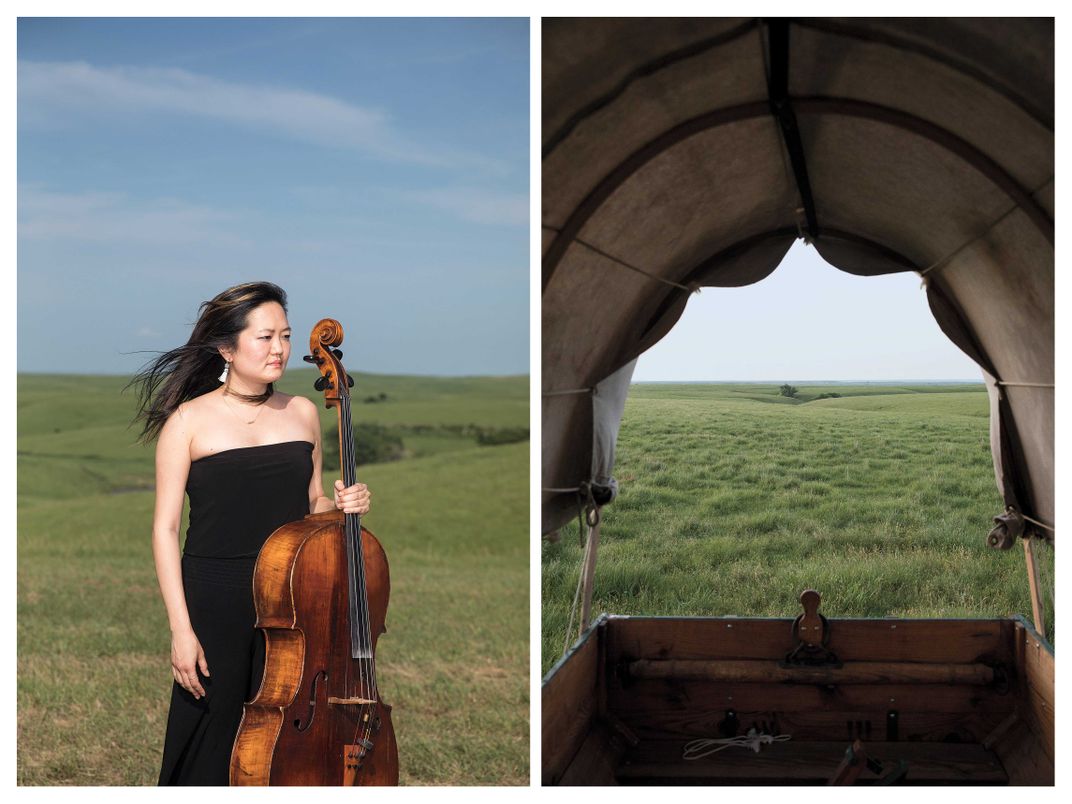
Where Seldom Is Heard a Discouraging Word
The Flint Hills National Scenic Byway, Kansas Route 177, runs north-south from Council Grove down to Cassoday. It is an astonishment. Don’t hurry. You’ll find yourself pulling over more than once to take advantage of what the locals call the viewshed.
And while this land demands to be walked, to be lived on, to be felt under your feet or galloped across, to drive these rolling hills at dawn or at dusk under a sky the color of saffron feels like the kind of proto-road trip that speaks to a mythology as powerful as that of the lonesome cowboy: cars and landscapes and speed. This isn’t the zombie driving we complain about on Midwestern interstates. It’s more like finding yourself in the closing scene of your own movie, or brushed into a painting by George Caleb Bingham. That light!
Windows down and the clean rush of air over the car, the cool and the shadows coming off the hills, the birdsong in the distance and the smooth turning of the world beneath you feels like a kind of optimism. And in those moments you can find in yourself a reminder of why so many for so long came west. From Europe, from the coast, from the East—the East with its Park Avenue aristocracy and its factories and its smokestacks, its boardrooms and its barren fisheries and exhausted forests, its hedge funds and its courtiers and its pedicures. Somehow, the East has always felt used up, at once corrupt and corrupting.
But, oh, the West! The West is somehow always new, still fresh, still green. The frontier closed more than 100 years ago, but the West of our imagination remains pristine and unpopulated. The illusion of which is our true inheritance. No matter the reality, the West is always America’s second chance.
Thus in the glow of myth and morning it’s easy to forget that energy extraction is the other big local business. It’s powering the car you’re riding in! It employs a lot of people hereabouts and pays out a lot on oil and gas leases to farmers and ranchers. The Koch brothers’ empire got its start just up the road, in fact, and their Flint Hills Resources company is headquartered over in Wichita. And a lot of that oil and a lot of that gas sits right under the Flint Hills.
So, to paraphrase Ben Franklin, the tallgrass prairie is an Eden—if you can keep it.
* * *
Elexa Dawson is dark-eyed and wears a single mom’s expression of tired amusement. We sat and talked at the Hoys’ place over in Cedar Point. She lives on the other side of the county with her two daughters, one of whom, 7-year-old Rosemary, has just finished telling us she can drive a skid loader and is a great dancer. Elexa holds down two part-time jobs—bartending at Ad Astra up in Strong City, and at Mulready’s over in Emporia. She’s also the lead singer and songwriter of the Skirts—whose mandolin player is Annie Wilson’s daughter, Emily—a popular local acoustic roots band that just released their second album, Mother. She’s an environmental activist, too.
Just about a year ago she raised objections to a proposed wastewater injection well out near Diamond Creek, not far from the Tallgrass Prairie Preserve. Along with several other women she was crowdfunding a legal campaign to oppose the high-pressure injection of saltwater—5,000 barrels of it a day—deep into the limestone. A consequence of which is often “human-induced seismic activity.” Earthquakes. They lost, but the Flint Hills Stewards were born.
“Also there are enhanced oil-recovery wells, where they’re pushing freshwater often into the earth down way below the water table, to extract oil and saltwater. The water usually doesn’t get recycled but put back down into these holes.
“So we’re polluting and depleting all of this water to get just a little bit of oil out of the ground. We are going to start talking to the rural water districts that are selling the water—to pressure them as consumers, to get them to stop selling it.”
Elexa worries about oil company earthquakes and polluted agribusiness runoff and wind farms and pesticides. Elexa is Native American—Potawatomi—and this is her home.
For hundreds of years, the Osage and the Wichita, the Pawnee and the Kansa—the People of the Southwind—all made their homes along the streams and rivers here, until forced farther south onto ever-shrinking holdings by settlers from the east. These were their communal hunting grounds and today are littered everywhere with knapped flint arrowheads. By the end of the 19th century, the Kansa were mostly gone from Kansas. Relocated to Oklahoma. This place is crowded with old ghosts.
“I have to take the time to restore my spirit and then go back out and resist again,” she says. “I need to spend time observing the prairie and observing the animals and plants that are there and undisturbed. Getting to escape and be in that place is very restorative for me. I think it empties my head, restores my soul, fills my heart. Being in that space helps me keep my calm center, always remembering, ‘OK, I’m not supposed to save the world, but I do have to do my little part, and I know why I’m doing it.’ The prairie is definitely the inspiration for all of it, the reason for the activism, for everything.”
And the Skies Are Not Cloudy All Day
The concert this year, lucky number 13, is down in Butler County, on the Rosalia Ranch of the Gottsch Cattle Company. The site takes up a couple hundred acres on the vast property. In fact the ranch is nearly the same size as the Tallgrass Prairie Preserve, 10,000 acres.
Lonnie and Carlos are volunteers. “This is my 12th year,” Lonnie says. “My favorite part is when they play the last tunes, and they drive the cattle across the prairie....I don’t care how many times you’ve seen it, it just takes your breath away.”
“Do you cry at the singing of ‘Home on the Range’?” Carlos asks.
“No, I’m past that.”
“You’re a hard man, Lonnie.”
“Yeah.”
* * *
“The Flint Hills are amazing,” says former Kansas governor and former Secretary of Health and Human Services Kathleen Sebelius. “You can see what First Americans saw on the prairie, with native grasses and wildlife. I knew what a treasure this land was in the heartland.” Symphony in the Flint Hills began under her tenure as governor. She and then-Senator Nancy Kassebaum worked to secure the Tallgrass Prairie National Preserve and collaborated with the Nature Conservancy to make sure that the park and surrounding lands were protected.
“One of the challenges,” says Sebelius, “was navigating an appropriate balance—we were able to secure with an agreement with utility companies not to purchase wind energy within a certain boundary, defined by already paved roads, and with landowners who agreed to the preservation area and to promote the voluntary boundaries.
“Senator Nancy Kassebaum was a champion for making sure that the finances would support the park area from being sold and developed.”
Maybe it is enough to say of Senator Kassebaum, now 86, and the causes and conservation she championed, that when she retired from Washington, when she came home, she settled here, in the Flint Hills, in the quiet of the tallgrass, not far from Council Grove.
Due respect to every man in Kansas, it feels like women made this happen.
* * *
The day is covered wagons and cowboys, horses and cattle, wind and sun. There’s a giant, labyrinthine story circle made of straw bales. Over there, just on the brow of that hill, tent talks from national experts on tallgrass and water (this year’s theme) and waterways and freshwater mussels and the little silver fish found hereabouts, Topeka shiners. Annie Wilson and her band, the Tallgrass Express, are walking around.
There are food tents and beverage tents and tents for the patrons and tents for the lectures and a tent for kids to try musical instruments. There’s a stargazing tent with telescopes the size of Civil War artillery pieces, and long lines of people asking questions like “Is that Venus?” (yes). “Can I see the International Space Station?” (no). There are tents for cookies and water and folding chairs, first aid and emergencies and guided prairie walks. They’ll all vanish in a day or two.
It’s Brigadoon. By way of Werner Herzog.
There’s a media tent, too, where the young, avid writers and artists and photographers of the Flint Hills Media Project come and go. They produce a stunning annual journal of the event. There’s an art tent, of course, because in addition to beef and grain, the American prairie has produced art and artists in great abundance. Something in that powerful isolation, maybe, the profound solitude of the plains, puts an artist in mind of heaven and earth and our place in things. Gwendolyn Brooks and Langston Hughes and W. Eugene Smith and Gordon Parks and Charlie Parker and William Burroughs are all connected to Kansas. The tallgrass prairie and the Flint Hills stand as their own subcategory of the Kansas arts, in every medium from music and poetry to pottery and photography and plein air painting. By acclamation, the greatest work of art ever produced in the Flint Hills is 1991’s PrairyErth, by William Least Heat-Moon. “If you draw two lines from the metropolitan corners of America,” he wrote, “one from New York City southwest to San Diego, and another from Miami northwest to Seattle, the intersection would fall a few miles from my position.” A wide, deep exploration of Chase County, it remains a canonical work of 20th-century American nonfiction. The Flint Hills Quilt Trail is worth traveling, as well.
The concert program tonight blends Aaron Copland and John Williams with Peggy Coolidge and Peter Boyer and Bedrich Smetana. The orchestra is in remarkable tune and the sky is a Maxfield Parrish wash of turquoise and orange, and Aoife O’Donovan has a voice like clear water from a silver pitcher. The audience is rapturous.
And why not? As Jason Seber says, “We try to program this concert so that it has a nice mix between the standard classical repertoire and some off-the-beaten-path pieces by major composers such as Aaron Copland; pieces that don’t normally get programmed in the concert hall, but are representative of the landscape. The theme this year was Waterways, so we ended up programming that Rolling River (Sketches on “Shenandoah”). In general, we’re thinking of what kind of music is going to be peaceful like the prairie, and expansive, open, wide.”
And Peter Boyer’s reimagined Shenandoah—and the Smetana and the Copland—all succeed tonight, wildly so, in part because each is familiar and lyrical without ever seeming shopworn. Everyone knows this music without knowing it. Smetana, a Czech, was describing in The Moldau the flow of the river Vltava through the countryside on its way to the city of Prague. Tonight his music is the wind across this green sea. Copland, America’s most emphatically American symphonic composer, has managed in every moment of The Red Pony to capture nature in art. “Morning on the Ranch” is audibly, recognizably exactly that to every rancher in this audience.
The signature showstopper from the time of the founding is the “Home on the Range” singalong closing the night. At that moment, Beethoven, Brahms or Bach have nothing on Dr. Brewster Higley, a Kansas transplant who composed it as a poem for his local newspaper in 1873 or so. Set to music by a neighbor, Daniel Kelley, and many times revised and rearranged since, it was made the Kansas state song in 1947. It is a thing to see 6,000 Kansans singing and swaying in the twilight. Tears welling, throats catching, the only hitch this year are the cattle. A dozen or so cowboys are meant to drive the picturesque little herd across a hill adjacent to the stage, but this year the beef are uncooperative, and stubbornly head wrongwise back the other way. Still, the sky is afire and O’Donovan’s voice cools a fevered world as she leads a joyful chorus in melody and solidarity. Turns out the ones likeliest to smile/cry are the old ranchers themselves, and tears stream down those rawboned cheeks unashamed. Folks head up the aisles, wiping their eyes.
“I thought it was great. The musicians, they’re world class. Them playing out here is a once-in-a-lifetime experience.”
“The landscape is what’s so amazing, because it’s Kansas and we think that it’s flat and it’s not.”
“Yep.”
“It’s not flat at all.”
“The soloist was, oh my gosh, her voice was just magical, absolutely magical.”
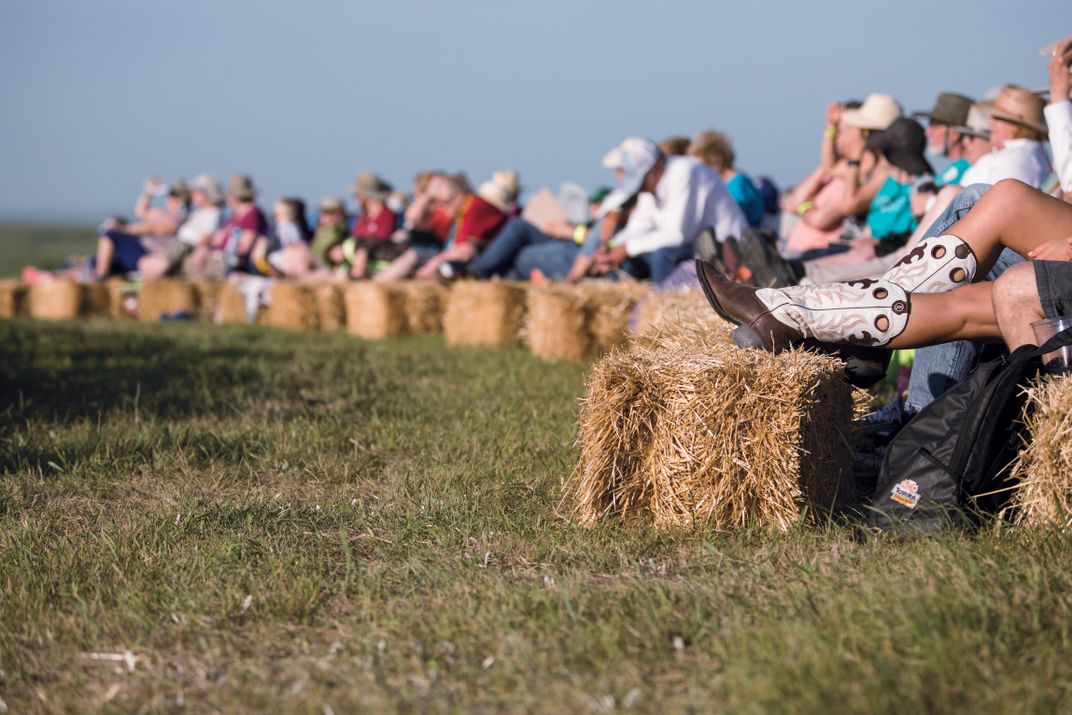
* * *
“I didn’t know what to expect,” O’Donovan says afterward. “I don’t think I could have possibly realized how cool it was gonna be until I was actually singing ‘Home on the Range’ as the sun was setting. It was really incredible.
“I had no idea something like that existed. Just kind of flabbergasted. More than anything I was struck by the sheer beauty and grandeur of the landscape and the fact that there’s an organization that gets an entire orchestra to the middle of the prairie, and there’s just this big community event. I felt like the people in the tallgrass prairie just had this love for the place. This want to revitalize, and for community that you find in really remote places. Even though it’s actually not that remote, we were only a couple of hours from Kansas City.
“Usually when I’ve done big orchestral outdoor concerts, I think people are there more to have a picnic, or chat with friends. People were really taking in the music in a way that often outdoor audiences don’t.
“I’m not sure why that was. Maybe just the fact that they were within this incredible natural amphitheater. But they were really listening. As a performer, looking out and seeing people responding to the music was as much of a gift as the beauty of the place.”
And with that, O’Donovan heads back out on the road.
* * *
There’s a long line for the telescopes at the stargazing tent. There’s the western swing trio Hot Club of Cowtown in the dance tent. There are cowboy poets in the story circle, and cowboy singers and cowboy listeners and cowboy hats and cowboy boots. Belt buckles big as the queen’s tea service. The stars fan out across the sky and everywhere you turn there are slow-dancers and hand-holders, bare-shouldered two-steppers and sly stolen-kissers, wanderers and wagon riders, all beneath a scimitar of crescent moon.
An hour or two later you’ll see Jason Seber in line at the McDonald’s down in El Dorado. Double Quarter Pounder Value Meal. “I think we played pretty well,” he’ll tell you.
People head for their cars to wait out the traffic. The road and the world seem far away. That’s it. That’s the end.
Home, Home on the Range
Walk with me.
It’s quieter now. Most folks are gone and just a few feet from the tents or the stage the light falls off until the world goes black. You step out into it. Somewhere behind you in the dark, Annie Wilson sings on.
:focal(2295x1114:2296x1115)/https://tf-cmsv2-smithsonianmag-media.s3.amazonaws.com/filer/da/a9/daa93520-adb4-4343-b4fb-81c2f57080b0/nov2018_d09_kansassymphony.jpg)
/https://tf-cmsv2-smithsonianmag-media.s3.amazonaws.com/accounts/headshot/Jeff_MacGregor2_thumbnail.png)

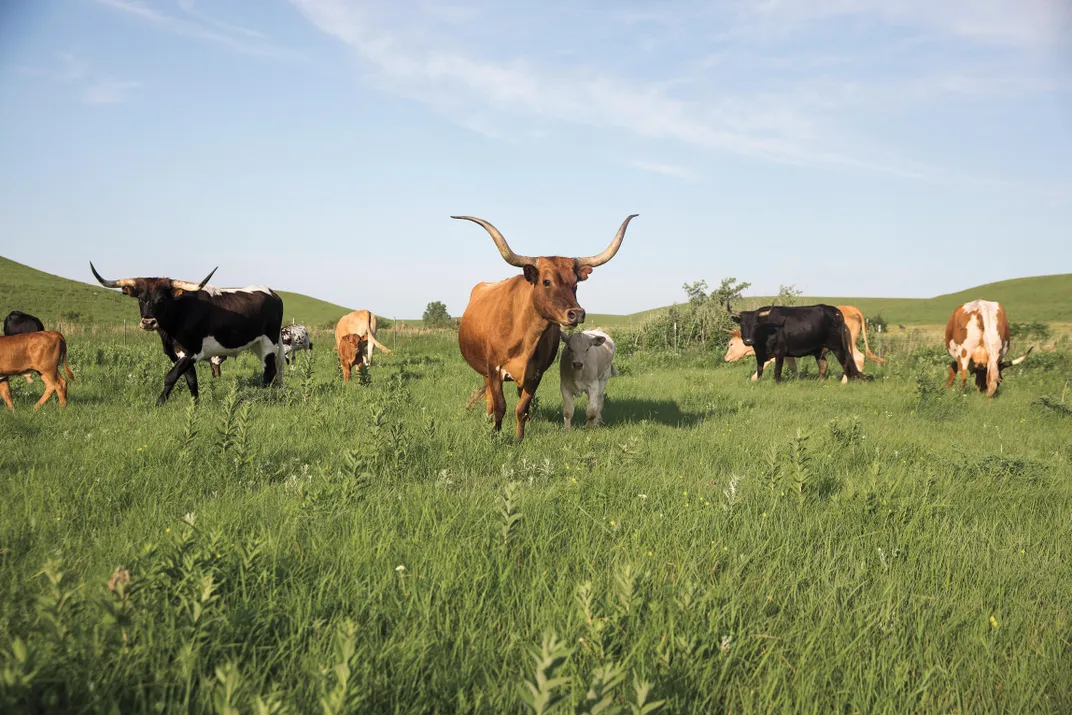
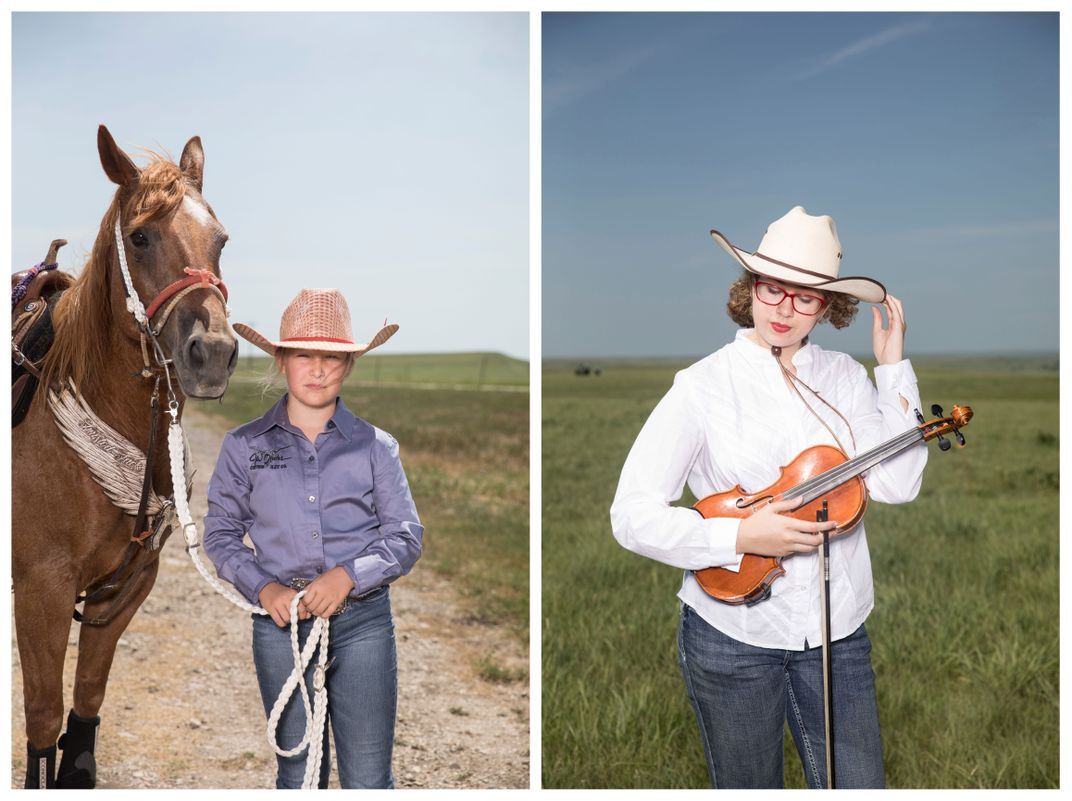
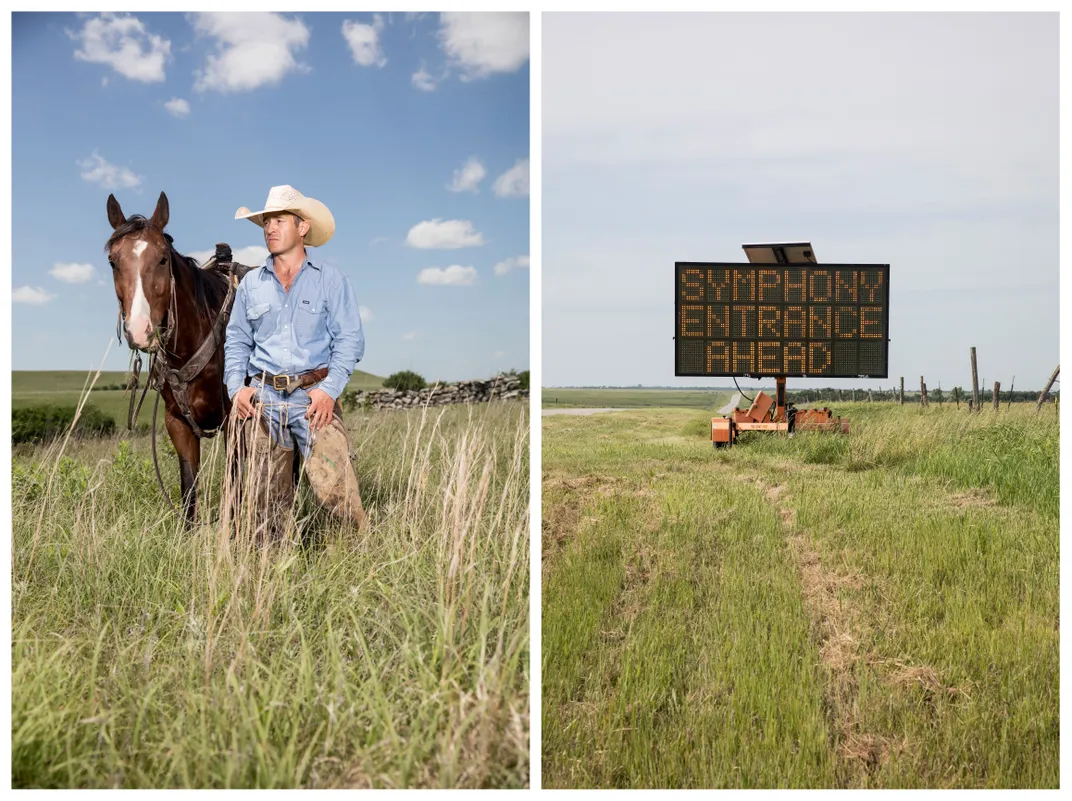
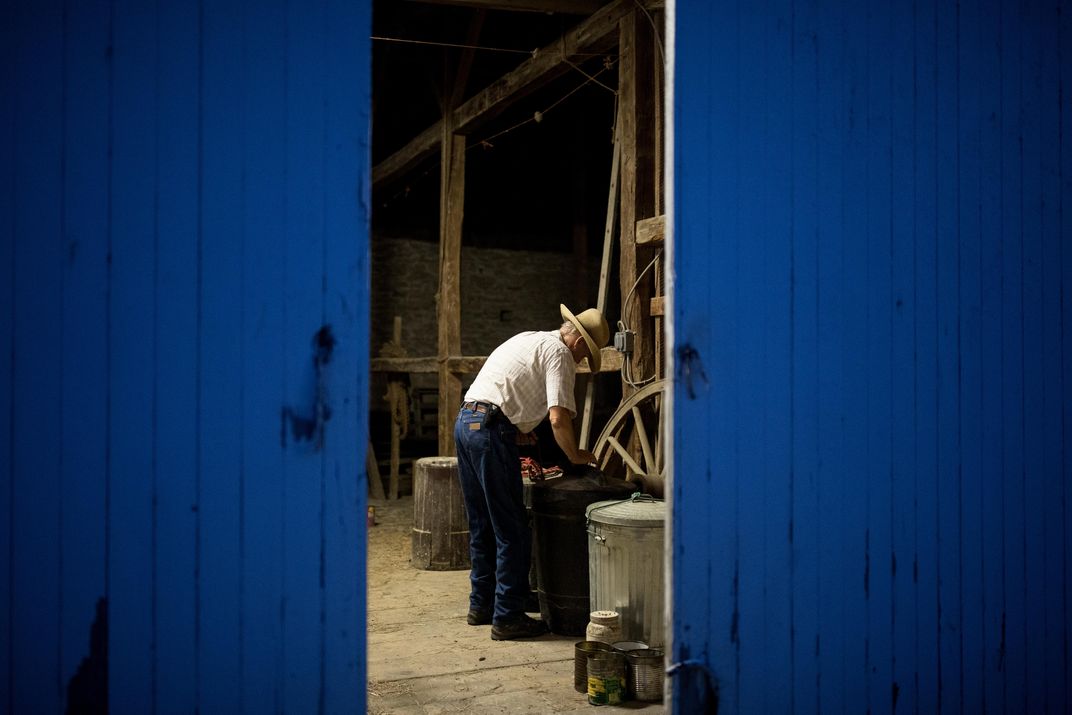
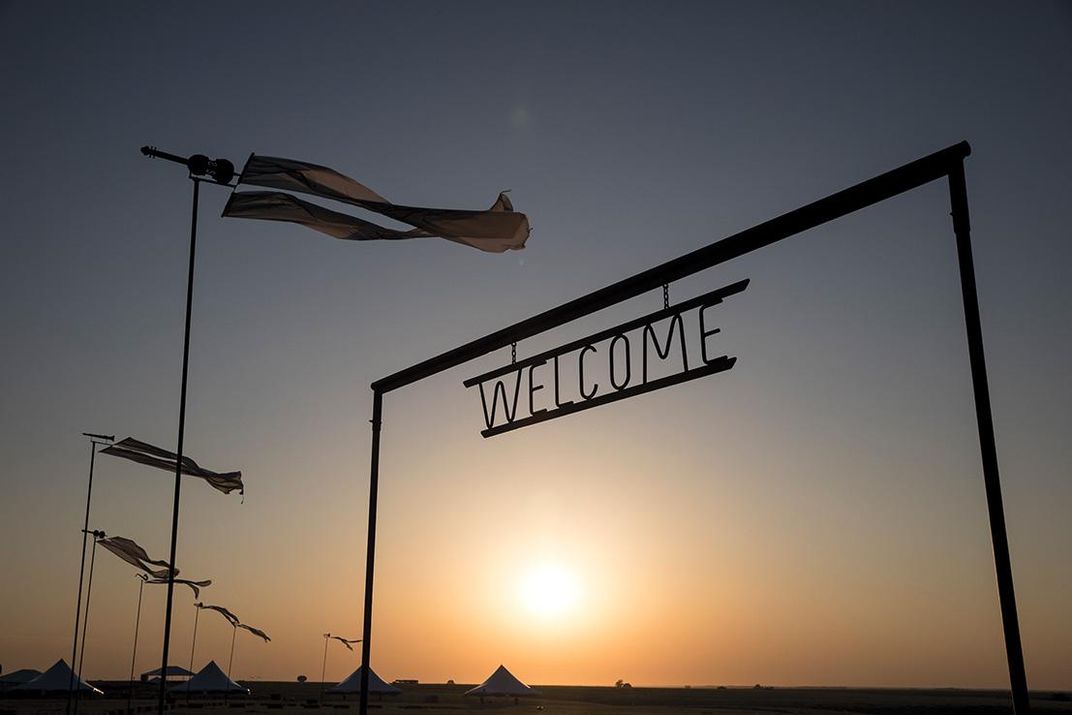
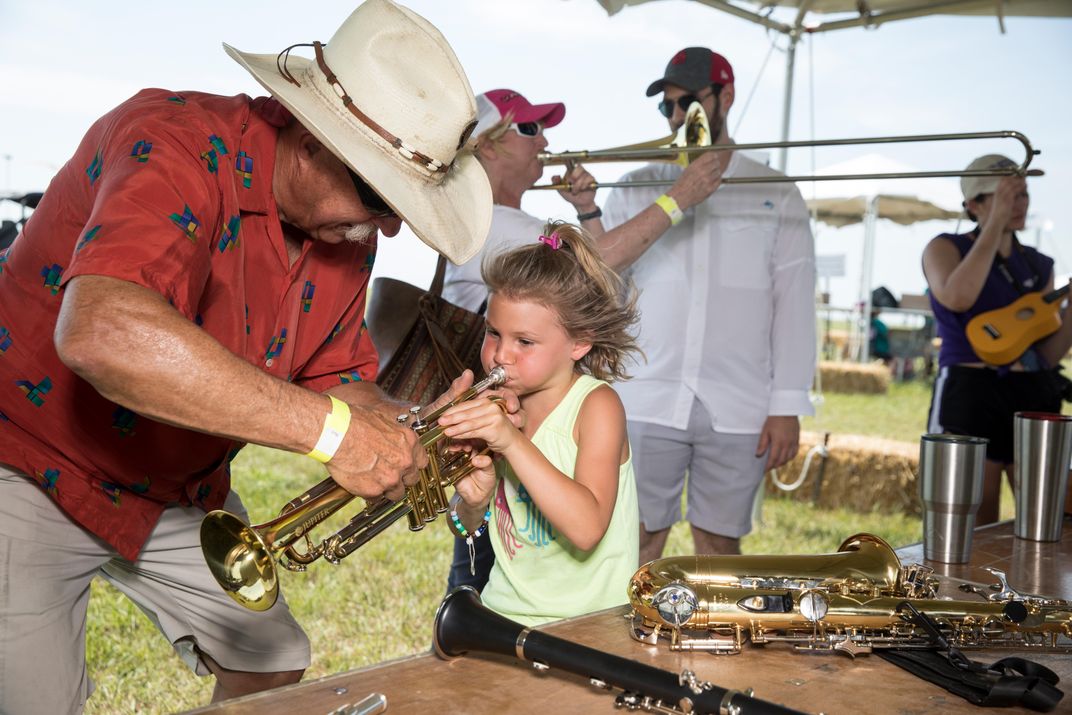
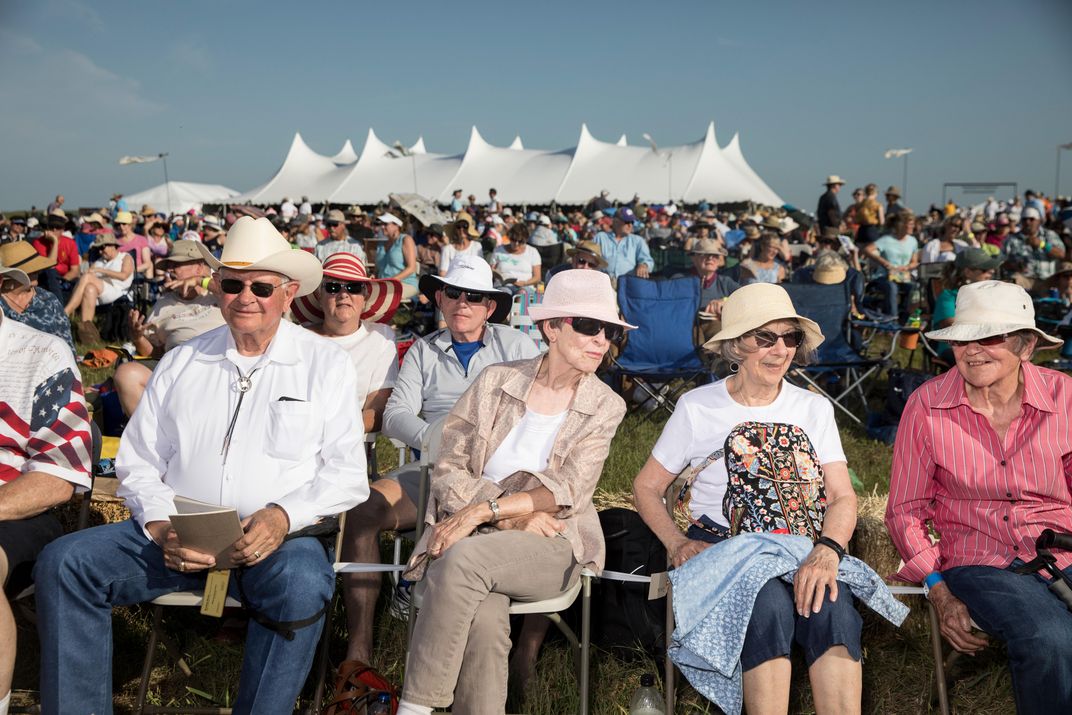
/https://tf-cmsv2-smithsonianmag-media.s3.amazonaws.com/accounts/headshot/Jeff_MacGregor2_thumbnail.png)